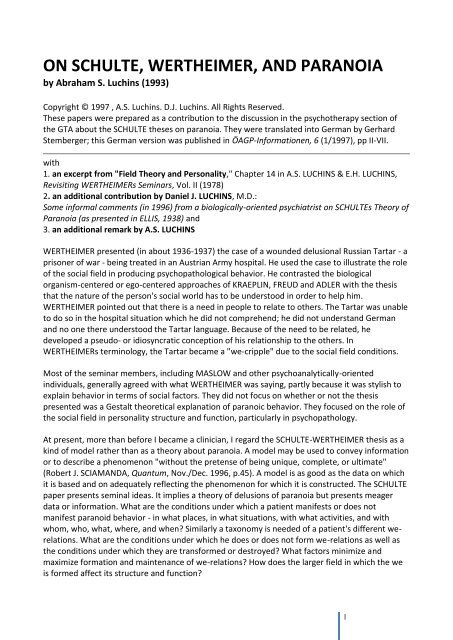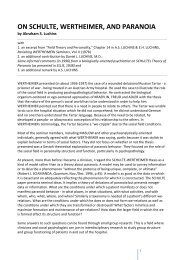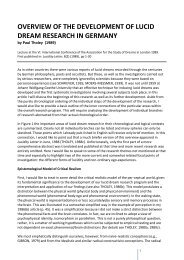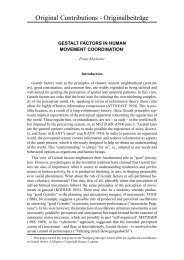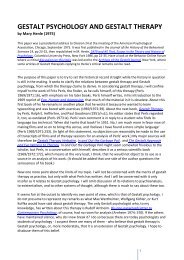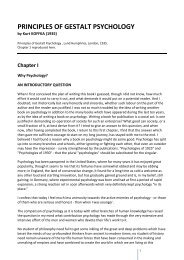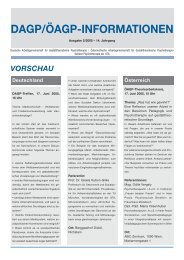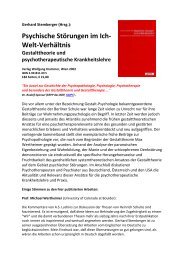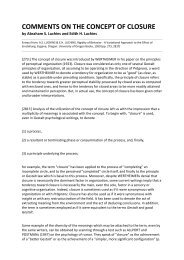pdf-Download - Society for Gestalt Theory and its Applications (GTA)
pdf-Download - Society for Gestalt Theory and its Applications (GTA)
pdf-Download - Society for Gestalt Theory and its Applications (GTA)
Create successful ePaper yourself
Turn your PDF publications into a flip-book with our unique Google optimized e-Paper software.
ON SCHULTE, WERTHEIMER, AND PARANOIA<br />
by Abraham S. Luchins (1993)<br />
Copyright © 1997 , A.S. Luchins. D.J. Luchins. All Rights Reserved.<br />
These papers were prepared as a contribution to the discussion in the psychotherapy section of<br />
the <strong>GTA</strong> about the SCHULTE theses on paranoia. They were translated into German by Gerhard<br />
Stemberger; this German version was published in ÖAGP-In<strong>for</strong>mationen, 6 (1/1997), pp II-VII.<br />
with<br />
1. an excerpt from "Field <strong>Theory</strong> <strong>and</strong> Personality," Chapter 14 in A.S. LUCHINS & E.H. LUCHINS,<br />
Revisiting WERTHEIMERs Seminars, Vol. II (1978)<br />
2. an additional contribution by Daniel J. LUCHINS, M.D.:<br />
Some in<strong>for</strong>mal comments (in 1996) from a biologically-oriented psychiatrist on SCHULTEs <strong>Theory</strong> of<br />
Paranoia (as presented in ELLIS, 1938) <strong>and</strong><br />
3. an additional remark by A.S. LUCHINS<br />
WERTHEIMER presented (in about 1936-1937) the case of a wounded delusional Russian Tartar - a<br />
prisoner of war - being treated in an Austrian Army hospital. He used the case to illustrate the role<br />
of the social field in producing psychopathological behavior. He contrasted the biological<br />
organism-centered or ego-centered approaches of KRAEPLIN, FREUD <strong>and</strong> ADLER with the thesis<br />
that the nature of the person's social world has to be understood in order to help him.<br />
WERTHEIMER pointed out that there is a need in people to relate to others. The Tartar was unable<br />
to do so in the hospital situation which he did not comprehend; he did not underst<strong>and</strong> German<br />
<strong>and</strong> no one there understood the Tartar language. Because of the need to be related, he<br />
developed a pseudo- or idiosyncratic conception of his relationship to the others. In<br />
WERTHEIMERs terminology, the Tartar became a "we-cripple" due to the social field conditions.<br />
Most of the seminar members, including MASLOW <strong>and</strong> other psychoanalytically-oriented<br />
individuals, generally agreed with what WERTHEIMER was saying, partly because it was stylish to<br />
explain behavior in terms of social factors. They did not focus on whether or not the thesis<br />
presented was a <strong>Gestalt</strong> theoretical explanation of paranoic behavior. They focused on the role of<br />
the social field in personality structure <strong>and</strong> function, particularly in psychopathology.<br />
At present, more than be<strong>for</strong>e I became a clinician, I regard the SCHULTE-WERTHEIMER thesis as a<br />
kind of model rather than as a theory about paranoia. A model may be used to convey in<strong>for</strong>mation<br />
or to describe a phenomenon "without the pretense of being unique, complete, or ultimate"<br />
(Robert J. SCIAMANDA, Quantum, Nov./Dec. 1996, p.45). A model is as good as the data on which<br />
it is based <strong>and</strong> on adequately reflecting the phenomenon <strong>for</strong> which it is constructed. The SCHULTE<br />
paper presents seminal ideas. It implies a theory of delusions of paranoia but presents meager<br />
data or in<strong>for</strong>mation. What are the conditions under which a patient manifests or does not<br />
manifest paranoid behavior - in what places, in what situations, with what activities, <strong>and</strong> with<br />
whom, who, what, where, <strong>and</strong> when? Similarly a taxonomy is needed of a patient's different werelations.<br />
What are the conditions under which he does or does not <strong>for</strong>m we-relations as well as<br />
the conditions under which they are trans<strong>for</strong>med or destroyed? What factors minimize <strong>and</strong><br />
maximize <strong>for</strong>mation <strong>and</strong> maintenance of we-relations? How does the larger field in which the we<br />
is <strong>for</strong>med affect <strong>its</strong> structure <strong>and</strong> function?<br />
1
Some answers to such questions can be found through small group research. This is a field where<br />
clinicians <strong>and</strong> social psychologists can join in interdisciplinary research to study group structure<br />
<strong>and</strong> group functioning of patients in <strong>and</strong> out of the hospital.<br />
Normal people also have hallucinations, delusions, or misperceptions <strong>and</strong> misconceptions. What<br />
are the differences <strong>and</strong> similarities between their experiences <strong>and</strong> the corresponding experiences<br />
of patients? And how do the ways in which individuals correct themselves compare <strong>for</strong> normal<br />
people <strong>and</strong> psychotic patients? Preliminary studies were undertaken with normal subjects, based<br />
on discussions in WERTHEIMERs seminars (e.g., WERTHEIMERs Seminars Revisited: Problems of<br />
Perception, Volume V, 1974, pp. 261 ff). Preliminary studies of patients' delusions <strong>and</strong><br />
hallucinations were made when I worked <strong>for</strong> the U.S. Army <strong>and</strong> Veterans Administration. Methods<br />
were also developed to help patients correct their delusions <strong>and</strong> hallucinations. The methods <strong>and</strong><br />
results are described in papers on group psychotherapy, e.g., the role of the social field in<br />
restructuring patients' perceptions. Some of the methods are related to the psychosocial biological<br />
approach used by Adolf MEYER (1913) <strong>for</strong> treating <strong>and</strong> rehabilitating patients to entertain<br />
alternative hypotheses as well as to the methods used by Oskar DIETHELM (1936/1955) to<br />
introduce hab<strong>its</strong> of doubt about false interpretations. Perhaps because of the disruption of<br />
communications in World War I, MEYERs paper may not have been read by SCHULTE. The<br />
methods are also related to Adhemar GELBs <strong>and</strong> Kurt GOLDSTEINs treatment <strong>and</strong> rehabilitation of<br />
brain-injured soldiers of World War I. It is of interest to compare the methods with those of moral<br />
treatment in American asylums in the nineteenth-century.<br />
In a general sense, the methods are similar to those described by WERTHEIMER <strong>for</strong> productive<br />
thinking, problem solving, teaching <strong>and</strong> learning. They also fit WERTHEIMERs challenge that the<br />
duty of the therapist is not merely to diagnose or theorize about the patient but to help him. It is a<br />
problem solving situation <strong>for</strong> both the patient <strong>and</strong> the therapist who, with social support, create a<br />
learning environment. The idea is change the patient's focus <strong>and</strong> to help him to recenter his<br />
concepts of his social relationships, e.g., through role-playing, psychodrama, <strong>and</strong> action research<br />
in his everyday life. The goal is to help the patient restructure his phenomenal world, to develop a<br />
viable world that is compatible with social reality. In my personal experiences, it is important to be<br />
optimistic about achieving this goal <strong>and</strong> to convey this optimism to the patient.<br />
Footnotes<br />
(1) Cf. Heinrich SCHULTE (1924). At the time of WERTHEIMERs seminars, the abridged translation<br />
("An Approach to a <strong>Gestalt</strong> <strong>Theory</strong> of Paranoia," Selection 31 in Willis D. ELLIS, A Source Book of<br />
<strong>Gestalt</strong> Psychology, Harcourt Brace, 1938) had not yet appeared. For a complete translation, see<br />
Erwin LEVY, "A <strong>Gestalt</strong> <strong>Theory</strong> of Paranoia," <strong>Gestalt</strong> <strong>Theory</strong>, Vol. 8 (4), 1986, pp. 230-255, who<br />
refers to the SCHULTE-WERTHEIMER theory. A.S. LUCHINS & E.H. LUCHINS, Revisiting<br />
WERTHEIMERs Seminars, Bucknell University Press, Vol. II, 1978. pp. 138-142, presents<br />
WERTHEIMERs comments on the case of the Tartar <strong>and</strong> paranoia.<br />
(2) Cf. A.S. LUCHINS, A Functional Approach to Training in Clinical Psychology via Study of a Mental<br />
Hospital, C.C. Thomas, 1959.<br />
(3) At times it was difficult to distinguish between delusions <strong>and</strong> what the psychiatrist Carl<br />
WERNICKE in 1906 called "overvalued ideas". Recently Paul R. McHUGH wrote "an overvalued<br />
value has three characteristics: (1) it is a self-dominating but not idiosyncratic opinion, given great<br />
importance by (2) internal emotional feelings over the significance, <strong>and</strong> evoking (3) persistent<br />
behavior in <strong>its</strong> service" (The American Scholar, Winter 1997, p.20).<br />
2
(4) Cf. "The Role of the Social Field in Psychotherapy," Journal of Consulting Psychology, 1948, Vol.<br />
XII, pp. 417-425 <strong>and</strong> "Restructuring Social Perceptions: A Group Psychotherapy Technique,"<br />
Journal of Consulting Psychology, 1950, Vol. XIV, pp. 446-451. A recent study at the University of<br />
Chicago Pritzker School of Medicine found that patients who were not demented could correct<br />
some of their misperceptions. The results were similar to ours.<br />
(5) Adolf MEYER, "The Treatment of Paranoic <strong>and</strong> Paranoid States," in William A. WHITE <strong>and</strong> Smith<br />
E. JELLIFFE, Eds., The Modern Treatment of Nervous <strong>and</strong> Mental Diseases, Volume I, pp. 614-661,<br />
Lea & Febiger, Philadelphia, 1913. Oskar DIETHELM, Treatment in Psychiatry, Macmillan, New<br />
York, 1936/1955.<br />
(6) Albert DEUTSCH, The Mentally Ill in America: A History of Their Care <strong>and</strong> Treatment from<br />
Colonial Times, Doubleday, Doran, Garden City, New York, 1937, Columbia University Press, New<br />
York, 1949. Nancy TOMES, A Generous Confidence: Thomas Story Kirkbride <strong>and</strong> the Art of Asylum<br />
Keeping, 1840-1883, Cambridge University Press, New York, 1983. A.S. LUCHINS, "Moral<br />
Treatment in Asylums <strong>and</strong> General Hospitals in 19th-Century America," The Journal of<br />
Psychology,123(6), 585-607, 1989; "The Cult of Curability <strong>and</strong> the Doctrine of Perfectibility: Social<br />
Context of the Nineteenth-Century American Asylum Movement," History of Psychiatry, iii, 203-<br />
220, 1992.<br />
(7) For example, Kurt GOLDSTEIN, The Organism; A Holistic Approach to Biology Derived from<br />
Pathological Data in Man. American Book Co., New York, 1939; Zone Books, New York, 1995.<br />
(8) Productive Thinking, Harper, 1945/1959, <strong>and</strong> "The Syllogism <strong>and</strong> Productive Thinking," 1925,<br />
Selection 23 in ELLIS, 1938.<br />
From "Field <strong>Theory</strong> <strong>and</strong> Personality,"<br />
Chapter 14 in A.S. LUCHINS & E.H. LUCHINS,<br />
Revisiting WERTHEIMERs Seminars, Vol. II, 1978, pp. 138-139<br />
WERTHEIMER presented an illustration from psychopathology to show the effects of the social<br />
field on a person (cf. SCHULTE, 1924). A wounded Russian Tartar was captured alone <strong>and</strong> treated<br />
in an Austrian Army Hospital where he developed delusions of being persecuted. He also heard<br />
voices, showed extreme anxiety <strong>and</strong> made suicidal attempts. This was diagnosed as an acute<br />
paranoid episode. WERTHEIMER asked, What is the cause of such behavior? According to<br />
KRAEPLIN, you must study his pedigree, look <strong>for</strong> paranoid tendencies in his history <strong>and</strong> look <strong>for</strong><br />
gl<strong>and</strong>ular disturbances. One tries to show that paranoia is due to innate disposition. According to<br />
psychoanalysis it has a homosexual basis; there<strong>for</strong>e, you study the historical development of the<br />
libido to find that it is due to unconscious homosexuality. You may find an unresolved Oedipus<br />
complex, he loves his father, is not loved by girls, he desires men but finds men cold, he thinks that<br />
they hate him, <strong>and</strong> there<strong>for</strong>e he gets delusions. In response to a question WERTHEIMER said that<br />
according to ADLER an inferiority complex causes paranoia <strong>and</strong> then asked, What do all these<br />
explanations have in common? The situation in which the man finds himself <strong>and</strong> what happens to<br />
him in it are ignored. Someone said that these theorists do look at the situation, they look at it in<br />
terms of their theories <strong>for</strong> the cues that indicate the operation of the factors that are basic in their<br />
theories. WERTHEIMER remarked, There is a lack of realization of what actually happens to the<br />
3
particular individual in the present. You get a different picture if you consider that the Tartar was<br />
captured alone <strong>and</strong> was placed in a strange hospital. He was brought into a field of which he is to<br />
be a part, a patient; he is a member of a group of people in a room all of whom talk to each other<br />
but not to him. In this field there are <strong>for</strong>ces that make him feel that they are against him; he is<br />
given medicine <strong>and</strong> an operation <strong>and</strong> is <strong>for</strong>ced to cooperate. He does not speak German, no one<br />
knew his Tartar language. He knows nothing of occidental hospitals; he cannot underst<strong>and</strong> the<br />
field that acts on him but he cannot escape. He is in a hospital of the enemy. What are they trying<br />
to do to me, it hurts, I cannot resist, I must do as they tell me. This led to excitement, caused<br />
tensions. He wants some sort of relation to the field, he feels in need of communication but<br />
cannot get it. He finally relates himself to it as the group versus him. A situation arose in which he<br />
wanted to become part of a We but he was a We-cripple. The focus of all his thinking is directed<br />
on this particular difficulty. He dashes himself against the obstacle, he is excited, bewildered,<br />
panicky. He feels something is wrong; he feels as someone apart from the others, as outside of the<br />
group. This feeling creates isolation, a feeling of I versus others; they versus me. His ego becomes<br />
important; it is an ego not related to anyone. WERTHEIMER asked, How does a man in such a<br />
situation behave? He might take it as a theater scene, but he hears the others talk <strong>and</strong> he is<br />
excluded. He wants to know what they are talking about; he makes a hypothesis; they are talking<br />
about me, against me. Everything now is interpreted in light of this conception of the situation;<br />
the disequilibrium is now changed into a equilibrium. They are talking about me, the doctor wants<br />
to poison me. The situation is now clarified; things have meaning; he has a relationship to the field<br />
<strong>and</strong> has a mode of conduct in it; he fights to save himself; he tries to escape by suicide.<br />
Someone interrupted to ask what happened to the Tartar. WERTHEIMER said, they got a man who<br />
understood the Tartar's dialect; he talked to him <strong>and</strong> he was cured.... WERTHEIMER remarked that<br />
some say that paranoia is never cured.<br />
Other Comments:<br />
Daniel J. LUCHINS, M.D.<br />
Some in<strong>for</strong>mal comments (in 1996) from a biologically-oriented<br />
psychiatrist on SCHULTEs <strong>Theory</strong> of Paranoia (as presented in<br />
ELLIS, 1938):<br />
1. Let me start by saying that the paper appears to be concentrating on abstraction. People need<br />
to feel part of a group (we-ness). When this is interrupted they may develop paranoia (ideas of<br />
reference, persecution or gr<strong>and</strong>iose illusions) to reestablish some we-ness. It may be useful to<br />
think of such behavior as related to a need to belong to a group -- but that doesn't mean that the<br />
"need to belong to a group" exists outside of our use of this as a construct.<br />
2. The theory is not biologically based. It makes no reference to the brain or to evolution.<br />
Currently most biological theories of psychopathology will make a reference to at least one of<br />
these. For example, you can argue that people develop misidentification syndrome because of<br />
damage to systems relating to facial recognition. Bowlby's work on depression as related to<br />
maternal deprivation experiments in monkeys <strong>and</strong> the biological importance of maternal-child<br />
bonding might be a second example.<br />
Paranoia may have to do with evolution. Phobias may have an evolutionary basis. The capacity to<br />
4
fear; the fear of falling; agrophobia - no place to hide - evolution has given us the fear of being cut<br />
off from the tribe, cut off from com<strong>for</strong>t; the social fear of strangers - a new face not in your tribe<br />
may be a threat. People have a need to be connected in a tribe, a family, a group, a "we."<br />
My own theory of paranoia would lean towards the evolutionary explanation. "If you don't know<br />
what's going on, it's safer to think that it involves you than to ignore it." You are walking in a<br />
wilderness 6 million years ago - a branch breaks - do you think it might mean that there is a tiger<br />
planning to jump on you or do you think, "Could it just be the wind?" It probably is to your<br />
advantage to have the first view, the "fall back" position, <strong>and</strong> turn to the alternative view when<br />
you know more about what is going on.<br />
When people don't know or trust what's going on, paranoia may occur. They probably fall back to<br />
a more familiar situation. For example, when the computer jams, you may think it means, "O.K..<br />
Watch out. You better watch out. It probably has to do with something you did."<br />
3. There is some support <strong>for</strong> this view. In experiments with hallucinogenics, students start to show<br />
paranoia when they stop knowing what is really going on, i.e., this is an experiment, that is an MD,<br />
I'm being paid to do this, etc. The same explanation probably relates to the increased paranoia<br />
seen in people who are deaf, new immigrants, after cataract surgery when visual images are<br />
interfered with, etc., etc. - all situations in which there is a breakdown in the usual ability to "know<br />
what is going on."<br />
4. Obviously, one could say that in all the situations discussed in 3, there is a reduction in "weness,"<br />
but I don't believe that is adds anything, <strong>and</strong> is rather too narrow. There is a breakdown in<br />
knowing what's going on. For example, I was walking past a parked car one day <strong>and</strong> the windshield<br />
wipers moved. I thought "Did I bang something, is there a light beam that I passed through?" I<br />
walked back to inspect it <strong>and</strong> they moved again. Then I realized the car had been turned off with<br />
the windshield wipers on automatic. But in the presence of a new situation that I didn't<br />
underst<strong>and</strong>, my first impulse was to be self-referential.<br />
Among biologically-oriented psychiatrists concerned with paranoia or schizophrenia, currently the<br />
emphasis is on neurotransmitters <strong>and</strong> neurochemistry. They may speculate about why patients do<br />
this or that action, but they are usually more concerned with why patients have obsessions than<br />
with the particular obsessions. Neurotransmission drugs <strong>and</strong> their effects, e.g., on dopamine, do<br />
not have to do with treatment of specific problems or actions. Why do patients repeatedly wash<br />
their h<strong>and</strong>s, check the door or the stove, or have ideas of reference of persecution? More<br />
discussion is needed of the content as well as of the function <strong>and</strong> purpose of paranoia in specific<br />
cases.*<br />
*Remark added by A.S. Luchins:<br />
With the drug approach, is there no place <strong>for</strong> psychotherapy to help the patient construct a livable<br />
world <strong>and</strong> take care of his everyday problems in the social field? My experiences indicate that<br />
drugs do not obviate psychosocial intervention which, moreover, can have the added dividend of<br />
helping the patient to comply with his drug regime. It is noteworthy that the biologically-oriented<br />
psychiatrist whose views were cited above believes that there should be more concern with the<br />
specific content of the paranoia.<br />
5


